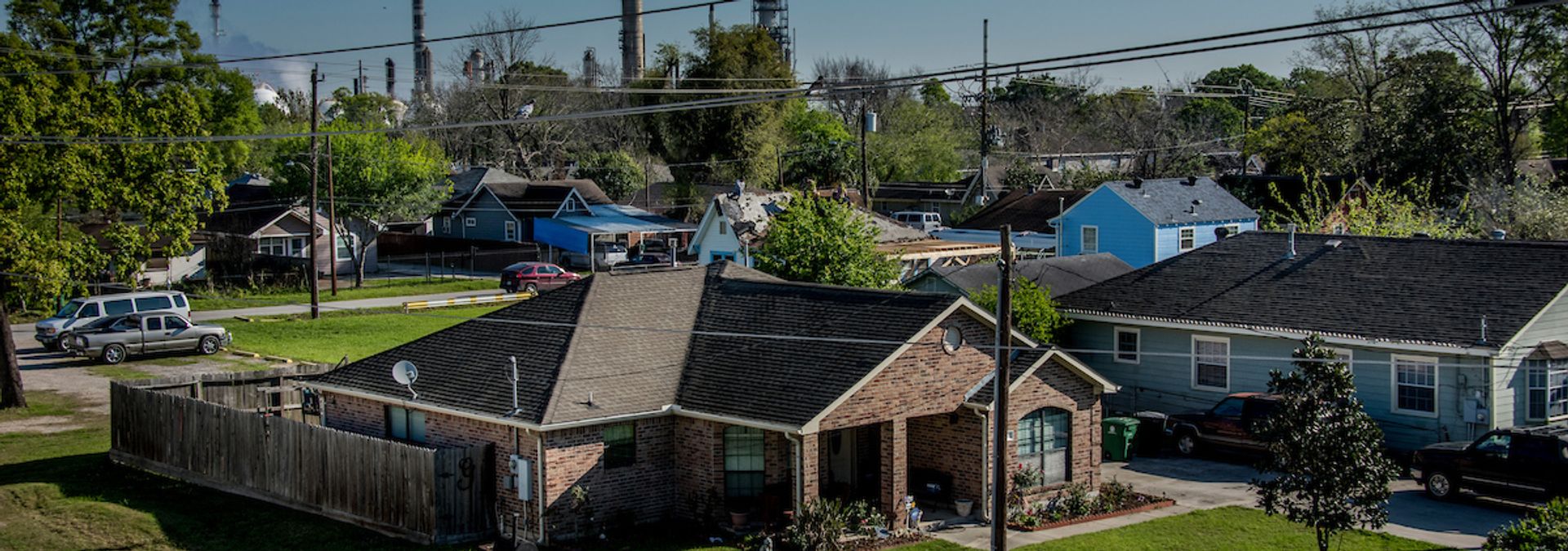
What is environmental racism?
The ease with which polluting facilities are sited in communities of color is just one example of environmental racism. Photo: Karen Kasmauski.
Understanding what environmental racism means begins with understanding the ways the two individual terms intersect.
Sometimes, environmental racism refers to the intentional degradation of shared natural resources like air, soil and water in communities of color.
Sometimes, it refers to systemic barriers that restrict access for people of color to necessities like fresh produce or high-quality medical care.
And sometimes, environmental racism refers to the overtly discriminatory policy decisions that are made at the local, state and federal level about how and where polluting facilities are permitted, parks are developed, public transit is routed, drainage infrastructure is improved, policing is heaviest and more.
Always, though, as Dr. Robert Bullard, distinguished professor of urban planning and environmental policy at Texas Southern University, has been writing since the 1980s, when he first started documenting the unequal presence of environmental hazards like dumps and incinerators and the disproportionate impacts of pollution in Houston, where you live largely determines your wealth and health.
How does environmental racism impact Houstonians?
Houston is home to one of the busiest ports in the world, with idling ships and heavy trucks moving goods in and out and through the city. It's home to dozens of industrial and petrochemical facilities, which routinely violate a host of environmental laws and regulations, spewing pollutants into the air, soil and water.
And Houston's low-lying urban sprawl is vulnerable to the increasing severity and violence of natural disasters like floods and hurricanes, made worse by the climate crisis.
These environmental realities expose all Houstonians to risk, but environmental racism makes the risks different for different communities. The practice of redlining, for example, played a role in determining land use throughout the city. Neighborhoods falsely labeled “definitely declining” or “hazardous” in the 1930s then experienced decades of depressed property values, which allowed polluters to move in. Today, these neighborhoods have a higher concentration of the toxic facilities that must report to the Environmental Protection Agency both within their boundaries and nearby.
Environmental racism like this creates unjust, unequal health impacts. Predominantly Black communities in Houston like Kashmere Gardens and Sunnyside suffer higher rates of asthma than the city average. The first cancer cluster in the City of Houston was confirmed in 2019 in the predominantly Black Fifth Ward, likely caused by creosote contamination at the nearby Union Pacific railyard.
As Catherine Flowers writes, exposure to air pollution disproportionately impacts Black and brown children, who suffer a range of health disparities compared with white children. During Hurricane Harvey, for example, nearly 340 tons of extra pollution were released by petrochemical facilities, nearly all of which was concentrated within four miles of Manchester, a neighborhood that is 98 percent Hispanic.
Overall, communities of color face reduced life expectancy and worsening health outcomes because of political and economic decisions others make, as Daniel E. Dawes, professor of health law and policy at Morehouse College, writes.
Now, the coronavirus pandemic is aggravating these disparities. According to an analysis of CDC data by the New York Times, Native Americans, Latino and Black people have been more likely to become infected than white people.
What can we do about it?
A recent survey by the Episcopal Health Foundation found that a majority of Texans believe that a top priority should be reducing air, waterand chemical pollution to improve health outcomes across the state. That shows that many Texans do not want to live with pollution, and they do not want their neighbors to, either.
As much of the social and political attention of our country focuses now on reducing racial disparities, there is a great need to act to reduce environmental racism and support the communities that are disproportionately impacted. Local, state and federal governments can invest in technology like air monitors, alert systems and other data-driven tools to prioritize resources for the communities with urgent needs.
It is important not to settle for making noise at the problem of environmental racism, but also to take anti-racist action. Those actions can include:
- Have regular open and honest conversations with colleagues, family members and friends to discuss environmental racism and methods to actively challenge disparities
- Actively monitor environmental problems and contact local representatives and environmental agency officials to report environmental incidents
- Hold individuals and industries accountable, through the judicial and legislative systems, for actions that violate the health and welfare of communities
- Encourage education systems to develop rigorous curricula that discuss racial disparities
- Develop mentor/mentee programs that encourage, educate, and empowers young people of color to become advocates for their communities
- Regularly promote the work of environmental advocates and leaders in the field that diligently work to reduce environmental disparities
- Volunteer with community organizations who seek to make a difference
- Collaborate with local leaders to create opportunities to reduce disparities within communities
- Host fundraisers and community events in collaboration with local leaders that advocate for and provide services to address the needs of the community
Semien is currently a PhD student at Texas A&M University studying urban and regional science. She holds a BS from Dillard University in biology and an MS from Texas Southern University in urban planning and environmental policy.
STAY UP TO DATE
The quality of our newsletter is considered satisfactory and poses little or no risk.
SUBSCRIBE

